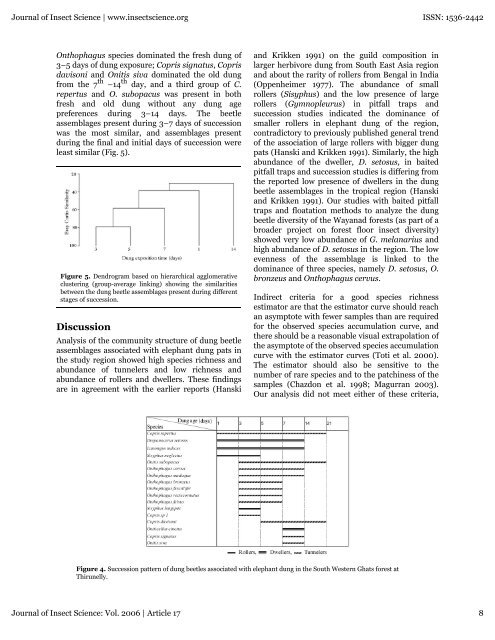Guild structure, diversity and succession of dung beetles associated ...
Guild structure, diversity and succession of dung beetles associated ...
Guild structure, diversity and succession of dung beetles associated ...
You also want an ePaper? Increase the reach of your titles
YUMPU automatically turns print PDFs into web optimized ePapers that Google loves.
Journal <strong>of</strong> Insect Science | www.insectscience.org ISSN: 1536-2442<br />
Onthophagus species dominated the fresh <strong>dung</strong> <strong>of</strong><br />
3–5 days <strong>of</strong> <strong>dung</strong> exposure; Copris signatus, Copris<br />
davisoni <strong>and</strong> Onitis siva dominated the old <strong>dung</strong><br />
from the 7 th –14 th day, <strong>and</strong> a third group <strong>of</strong> C.<br />
repertus <strong>and</strong> O. subopacus was present in both<br />
fresh <strong>and</strong> old <strong>dung</strong> without any <strong>dung</strong> age<br />
preferences during 3–14 days. The beetle<br />
assemblages present during 3–7 days <strong>of</strong> <strong>succession</strong><br />
was the most similar, <strong>and</strong> assemblages present<br />
during the final <strong>and</strong> initial days <strong>of</strong> <strong>succession</strong> were<br />
least similar (Fig. 5).<br />
Figure 5. Dendrogram based on hierarchical agglomerative<br />
clustering (group-average linking) showing the similarities<br />
between the <strong>dung</strong> beetle assemblages present during different<br />
stages <strong>of</strong> <strong>succession</strong>.<br />
Discussion<br />
Analysis <strong>of</strong> the community <strong>structure</strong> <strong>of</strong> <strong>dung</strong> beetle<br />
assemblages <strong>associated</strong> with elephant <strong>dung</strong> pats in<br />
the study region showed high species richness <strong>and</strong><br />
abundance <strong>of</strong> tunnelers <strong>and</strong> low richness <strong>and</strong><br />
abundance <strong>of</strong> rollers <strong>and</strong> dwellers. These findings<br />
are in agreement with the earlier reports (Hanski<br />
<strong>and</strong> Krikken 1991) on the guild composition in<br />
larger herbivore <strong>dung</strong> from South East Asia region<br />
<strong>and</strong> about the rarity <strong>of</strong> rollers from Bengal in India<br />
(Oppenheimer 1977). The abundance <strong>of</strong> small<br />
rollers (Sisyphus) <strong>and</strong> the low presence <strong>of</strong> large<br />
rollers (Gymnopleurus) in pitfall traps <strong>and</strong><br />
<strong>succession</strong> studies indicated the dominance <strong>of</strong><br />
smaller rollers in elephant <strong>dung</strong> <strong>of</strong> the region,<br />
contradictory to previously published general trend<br />
<strong>of</strong> the association <strong>of</strong> large rollers with bigger <strong>dung</strong><br />
pats (Hanski <strong>and</strong> Krikken 1991). Similarly, the high<br />
abundance <strong>of</strong> the dweller, D. setosus, in baited<br />
pitfall traps <strong>and</strong> <strong>succession</strong> studies is differing from<br />
the reported low presence <strong>of</strong> dwellers in the <strong>dung</strong><br />
beetle assemblages in the tropical region (Hanski<br />
<strong>and</strong> Krikken 1991). Our studies with baited pitfall<br />
traps <strong>and</strong> floatation methods to analyze the <strong>dung</strong><br />
beetle <strong>diversity</strong> <strong>of</strong> the Wayanad forests (as part <strong>of</strong> a<br />
broader project on forest floor insect <strong>diversity</strong>)<br />
showed very low abundance <strong>of</strong> G. melanarius <strong>and</strong><br />
high abundance <strong>of</strong> D. setosus in the region. The low<br />
evenness <strong>of</strong> the assemblage is linked to the<br />
dominance <strong>of</strong> three species, namely D. setosus, O.<br />
bronzeus <strong>and</strong> Onthophagus cervus.<br />
Indirect criteria for a good species richness<br />
estimator are that the estimator curve should reach<br />
an asymptote with fewer samples than are required<br />
for the observed species accumulation curve, <strong>and</strong><br />
there should be a reasonable visual extrapolation <strong>of</strong><br />
the asymptote <strong>of</strong> the observed species accumulation<br />
curve with the estimator curves (Toti et al. 2000).<br />
The estimator should also be sensitive to the<br />
number <strong>of</strong> rare species <strong>and</strong> to the patchiness <strong>of</strong> the<br />
samples (Chazdon et al. 1998; Magurran 2003).<br />
Our analysis did not meet either <strong>of</strong> these criteria,<br />
Figure 4. Succession pattern <strong>of</strong> <strong>dung</strong> <strong>beetles</strong> <strong>associated</strong> with elephant <strong>dung</strong> in the South Western Ghats forest at<br />
Thirunelly.<br />
Journal <strong>of</strong> Insect Science: Vol. 2006 | Article 17 8
















